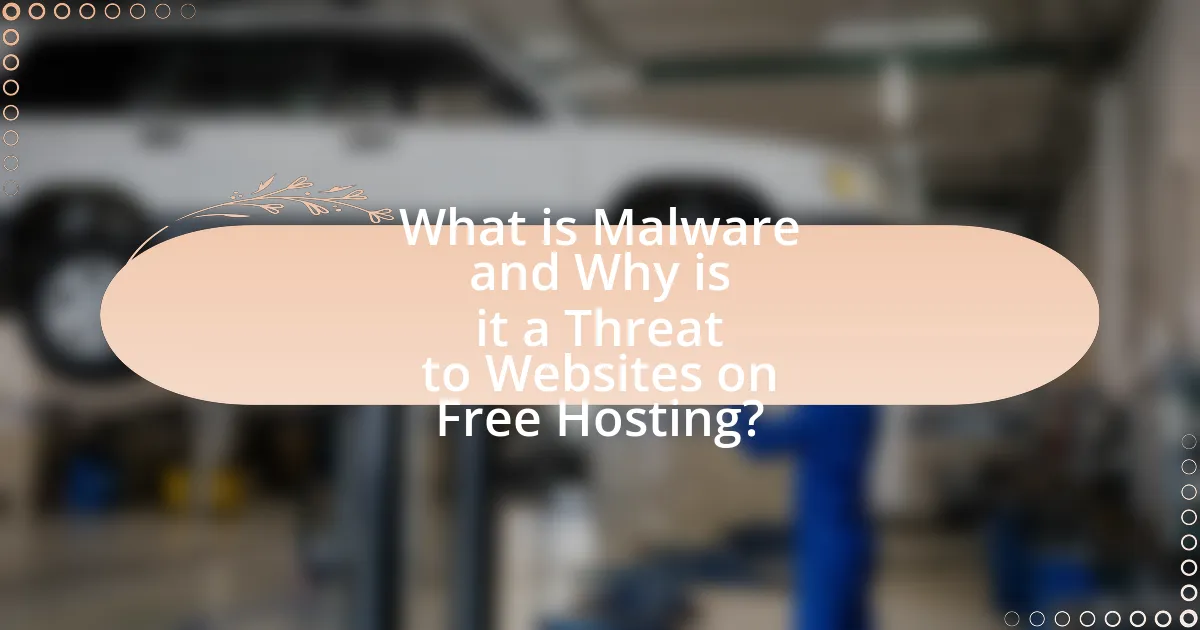Malware, or malicious software, poses a significant threat to websites hosted on free platforms due to their inherent vulnerabilities and lack of robust security measures. This article explores how malware infects these sites, the common types of malware targeting them, and the detrimental effects on website performance and security. It also outlines preventive measures, including regular software updates, strong password practices, and the use of security plugins, to safeguard against malware attacks. Additionally, the article provides guidance on identifying, removing, and recovering from malware infections, emphasizing the importance of ongoing security practices and user education in maintaining website integrity.

What is Malware and Why is it a Threat to Websites on Free Hosting?
Malware is malicious software designed to harm, exploit, or otherwise compromise computer systems and networks. Websites on free hosting are particularly vulnerable to malware because they often lack robust security measures, making them easy targets for attackers. According to a 2021 report by the cybersecurity firm Symantec, free hosting services are frequently exploited due to their limited resources and security protocols, leading to a higher incidence of malware infections. This vulnerability can result in data breaches, loss of sensitive information, and damage to the website’s reputation, underscoring the significant threat malware poses to such platforms.
How does malware typically infect websites hosted for free?
Malware typically infects websites hosted for free through vulnerabilities in the hosting platform and insecure coding practices. Free hosting services often lack robust security measures, making them attractive targets for attackers who exploit outdated software, weak passwords, or unpatched vulnerabilities. For instance, a study by the Cybersecurity & Infrastructure Security Agency (CISA) highlighted that many free hosting providers do not regularly update their systems, leaving them susceptible to known exploits. Additionally, attackers may use phishing techniques to gain access to user accounts, further facilitating malware deployment on these platforms.
What are the common types of malware that target free hosting platforms?
Common types of malware that target free hosting platforms include website defacers, phishing kits, and backdoors. Website defacers alter the appearance of a website to display unauthorized content, often for political or ideological reasons. Phishing kits are designed to steal user credentials by mimicking legitimate sites, exploiting the trust of users. Backdoors allow attackers to gain unauthorized access to the server, enabling them to execute commands or upload additional malicious software. These types of malware are prevalent due to the often lax security measures associated with free hosting services, making them attractive targets for cybercriminals.
How can malware affect the performance and security of a website?
Malware can significantly degrade the performance and security of a website by causing slow loading times, unauthorized access, and data breaches. When malware infects a website, it can lead to increased server load, resulting in slower response times and potential downtime. Additionally, malware can create vulnerabilities that allow hackers to exploit the site, leading to unauthorized access to sensitive information, which can compromise user data and trust. According to a report by Symantec, 54% of websites experience some form of malware attack, highlighting the prevalence and impact of such threats on website security and performance.
Why is free hosting particularly vulnerable to malware attacks?
Free hosting is particularly vulnerable to malware attacks due to its lack of robust security measures and limited resources for maintenance. Many free hosting providers do not implement advanced security protocols, leaving websites exposed to threats. Additionally, shared server environments increase the risk, as vulnerabilities in one site can compromise others on the same server. According to a report by the Cybersecurity & Infrastructure Security Agency, free hosting services are often targeted by attackers because they attract less scrutiny and have fewer defenses compared to paid hosting options.
What limitations do free hosting services impose that increase vulnerability?
Free hosting services impose limitations such as lack of security features, restricted server resources, and absence of customer support, which collectively increase vulnerability. These services often do not provide essential security measures like SSL certificates or firewalls, leaving websites exposed to attacks. Additionally, limited server resources can lead to performance issues, making sites more susceptible to denial-of-service attacks. The absence of reliable customer support means that vulnerabilities may go unaddressed for extended periods, further increasing the risk of exploitation.
How does the lack of support and resources in free hosting contribute to security risks?
The lack of support and resources in free hosting significantly contributes to security risks by leaving websites vulnerable to attacks and exploitation. Free hosting services often do not provide adequate security measures, such as regular updates, firewalls, or malware scanning, which are essential for protecting websites from threats. For instance, a study by the Cybersecurity & Infrastructure Security Agency (CISA) indicates that unpatched software vulnerabilities are a leading cause of security breaches, and free hosting platforms typically lack the resources to implement timely updates. Additionally, the absence of technical support means that users may not receive assistance in addressing security issues, further increasing the likelihood of successful attacks.

What Steps Can You Take to Protect Your Website from Malware?
To protect your website from malware, implement a combination of security measures including regular software updates, strong passwords, and security plugins. Regularly updating your website’s software, including the content management system and plugins, reduces vulnerabilities that malware can exploit. Using strong, unique passwords for all accounts associated with your website minimizes the risk of unauthorized access. Additionally, installing security plugins can provide real-time monitoring and malware scanning, which helps in identifying and mitigating threats promptly. According to a report by the Cybersecurity & Infrastructure Security Agency, 90% of successful cyberattacks exploit known vulnerabilities, emphasizing the importance of these protective steps.
How can you implement basic security measures on your free hosting site?
To implement basic security measures on your free hosting site, you should regularly update your software and plugins, use strong passwords, and enable HTTPS. Regular updates ensure that any vulnerabilities in the software are patched, reducing the risk of exploitation. Strong passwords prevent unauthorized access, as weak passwords are easily guessed or cracked. Enabling HTTPS encrypts data transmitted between the user and the site, protecting sensitive information from interception. According to a study by Google, sites using HTTPS are less likely to be compromised, highlighting the importance of this measure in maintaining security.
What role does regular software updates play in website security?
Regular software updates are crucial for website security as they patch vulnerabilities that could be exploited by attackers. When software is updated, developers often fix security flaws that have been identified, thereby reducing the risk of unauthorized access and data breaches. For instance, according to a report by the Cybersecurity & Infrastructure Security Agency (CISA), 85% of successful cyberattacks exploit known vulnerabilities for which patches are available. Therefore, consistently applying updates helps maintain a secure environment, protecting websites from malware and other threats.
How can strong passwords and user authentication enhance security?
Strong passwords and user authentication significantly enhance security by making unauthorized access more difficult. Strong passwords, which typically include a mix of letters, numbers, and special characters, reduce the likelihood of successful brute-force attacks. According to a study by the National Institute of Standards and Technology (NIST), using complex passwords can increase resistance to guessing attacks by exponentially increasing the number of possible combinations.
User authentication methods, such as two-factor authentication (2FA), add an additional layer of security by requiring users to provide a second form of verification, such as a code sent to their mobile device. This means that even if a password is compromised, unauthorized access is still prevented unless the second factor is also obtained. Research from Google indicates that 2FA can block 100% of automated bots and 96% of phishing attacks, demonstrating its effectiveness in enhancing security.
Together, strong passwords and robust user authentication mechanisms create a formidable barrier against unauthorized access, thereby protecting sensitive information and reducing the risk of malware infiltration on websites.
What tools and resources are available for malware protection?
Malware protection tools and resources include antivirus software, firewalls, and website security services. Antivirus software such as Norton, McAfee, and Bitdefender actively scan and remove malware from systems. Firewalls, both hardware and software-based, monitor incoming and outgoing traffic to block malicious activities. Additionally, website security services like Sucuri and Wordfence provide specialized protection for websites, offering malware scanning, removal, and real-time monitoring. These tools are essential for maintaining the integrity and security of websites, especially those hosted on free platforms, where vulnerabilities may be more prevalent.
Which security plugins are recommended for websites on free hosting?
Recommended security plugins for websites on free hosting include Wordfence Security, Sucuri Security, and iThemes Security. Wordfence Security offers a comprehensive firewall and malware scanner, which is essential for protecting sites on limited resources. Sucuri Security provides a robust suite of security features, including activity auditing and security hardening, which are crucial for free hosting environments. iThemes Security focuses on preventing unauthorized access and includes features like two-factor authentication and brute force protection, making it a strong choice for enhancing security on free hosting platforms. These plugins are widely recognized for their effectiveness in safeguarding websites against malware and other security threats.
How can website monitoring services help in detecting malware?
Website monitoring services help in detecting malware by continuously scanning websites for suspicious activities and known malware signatures. These services utilize automated tools that analyze website files, server responses, and traffic patterns to identify anomalies indicative of malware infections. For instance, a study by the Cybersecurity & Infrastructure Security Agency (CISA) highlights that regular monitoring can reduce the time to detect and respond to malware threats, thereby minimizing potential damage. Additionally, many monitoring services provide real-time alerts, enabling website owners to take immediate action when malware is detected, further reinforcing the effectiveness of these services in maintaining website security.

What Should You Do if Your Website is Infected with Malware?
If your website is infected with malware, immediately take it offline to prevent further damage and protect visitors. Next, conduct a thorough scan using reputable security software to identify and remove the malware. After cleaning the site, update all software, plugins, and themes to their latest versions to close vulnerabilities. Additionally, restore your website from a clean backup if available, and change all passwords associated with the site. Implement security measures such as firewalls and regular monitoring to prevent future infections. According to a report by Symantec, 54% of websites are vulnerable to malware attacks, highlighting the importance of proactive security measures.
How can you identify if your website has been compromised?
You can identify if your website has been compromised by checking for unusual activity, such as unexpected changes to content, unauthorized access to admin accounts, or the presence of unfamiliar files and scripts. Additionally, monitor your website’s traffic for spikes or patterns that seem abnormal, as these can indicate malicious activity. Security tools and plugins can also scan for vulnerabilities and malware signatures, providing alerts if any issues are detected. According to a report by the Cybersecurity & Infrastructure Security Agency, compromised websites often exhibit signs like defaced pages or redirects to malicious sites, reinforcing the importance of regular monitoring and security assessments.
What signs indicate a malware infection on your website?
Signs indicating a malware infection on your website include unexpected redirects, slow loading times, and the presence of unfamiliar files or scripts. Unexpected redirects occur when users are sent to different websites without their consent, often indicating malicious code. Slow loading times can result from malware consuming server resources, affecting performance. Additionally, unfamiliar files or scripts may appear in your website’s directories, suggesting unauthorized changes made by attackers. These signs are critical for identifying potential malware infections and taking necessary actions to secure your website.
How can you scan your website for malware effectively?
To scan your website for malware effectively, utilize a combination of automated scanning tools and manual checks. Automated tools like Sucuri SiteCheck or Wordfence can quickly identify malware, vulnerabilities, and security issues by scanning your website’s files and database. These tools often provide detailed reports and recommendations for remediation. Additionally, performing manual checks, such as reviewing your website’s code for suspicious changes or monitoring server logs for unusual activity, can help detect malware that automated tools might miss. According to a report by the Cybersecurity & Infrastructure Security Agency, regular scanning and monitoring are essential practices for maintaining website security and preventing malware infections.
What steps should you take to remove malware from your website?
To remove malware from your website, first, back up your website files and database to prevent data loss. Next, scan your website using a reputable malware scanner, such as Sucuri or Wordfence, to identify infected files. After identifying the malware, manually remove the infected files or restore clean versions from your backup. Additionally, update all software, plugins, and themes to their latest versions to close security vulnerabilities. Finally, change all passwords associated with your website, including database and FTP credentials, to prevent further unauthorized access. These steps are essential as they help ensure the integrity and security of your website after a malware infection.
How can you restore your website from a backup after a malware attack?
To restore your website from a backup after a malware attack, first, access your backup files, which should be stored securely, either on your hosting provider’s server or an external storage solution. Next, delete the infected files from your website to prevent the malware from re-infecting the restored version. Then, upload the backup files to your website’s server, ensuring that you overwrite any existing files. Finally, verify that the restoration was successful by checking the website’s functionality and running a malware scan to confirm that no remnants of the malware remain. This process is essential as it helps to ensure the integrity and security of your website post-attack.
What preventive measures should you implement post-removal to avoid future infections?
To avoid future infections post-removal, implement regular software updates, utilize strong passwords, and conduct frequent security scans. Regular software updates ensure that vulnerabilities are patched, reducing the risk of malware exploitation. Strong passwords, particularly those that are complex and unique, help prevent unauthorized access to your website. Frequent security scans can identify potential threats early, allowing for timely intervention. According to a study by the Ponemon Institute, organizations that regularly update their software reduce the risk of breaches by up to 80%.
What are the best practices for ongoing website security on free hosting?
The best practices for ongoing website security on free hosting include regularly updating software, using strong passwords, implementing HTTPS, and monitoring for vulnerabilities. Regular software updates are crucial as they patch security flaws; for instance, outdated plugins can be exploited by attackers. Strong passwords, ideally a mix of letters, numbers, and symbols, help prevent unauthorized access; studies show that 81% of data breaches are due to weak passwords. Implementing HTTPS encrypts data between the user and the server, enhancing security against eavesdropping. Additionally, monitoring for vulnerabilities through tools like security scanners can identify potential threats before they are exploited. These practices collectively strengthen the security posture of websites hosted on free platforms.
How often should you review and update your security measures?
You should review and update your security measures at least quarterly. Regular reviews help identify vulnerabilities and adapt to evolving threats, as cyber threats are constantly changing. According to the 2021 Cybersecurity Almanac, cybercrime is projected to cost the world $10.5 trillion annually by 2025, highlighting the importance of proactive security management. Additionally, the National Institute of Standards and Technology (NIST) recommends continuous monitoring and regular updates to security protocols to maintain effective defenses against potential attacks.
What role does user education play in maintaining website security?
User education plays a critical role in maintaining website security by equipping individuals with the knowledge to recognize and mitigate potential threats. Educated users are less likely to fall victim to phishing attacks, which accounted for 90% of data breaches in 2020, according to the Verizon Data Breach Investigations Report. Furthermore, training users on best practices, such as creating strong passwords and recognizing suspicious activity, significantly reduces the risk of security incidents. By fostering a culture of security awareness, organizations can enhance their overall defense against cyber threats, making user education an essential component of website security strategies.